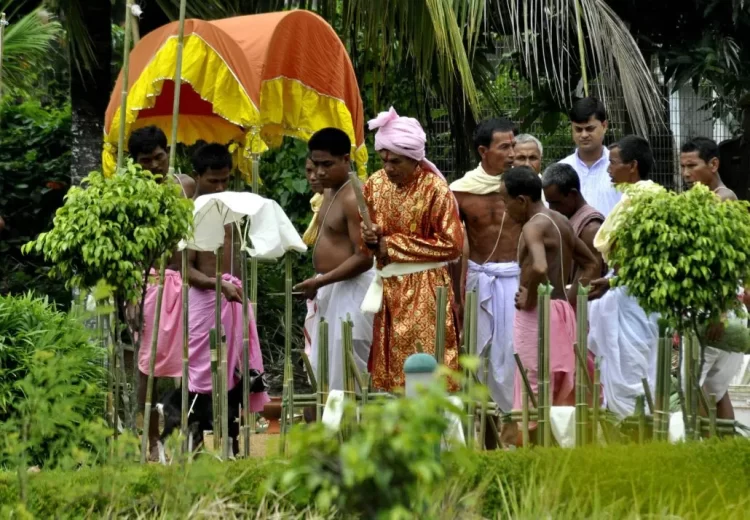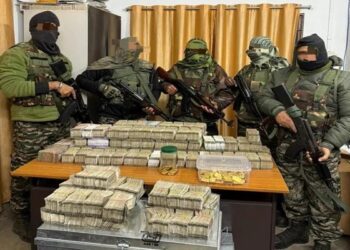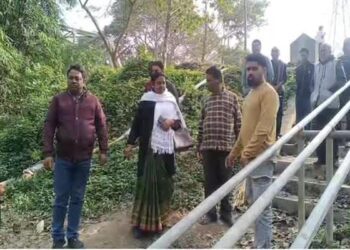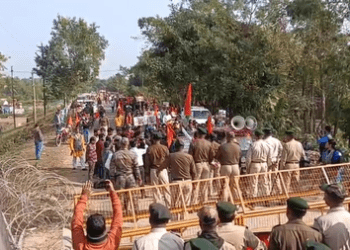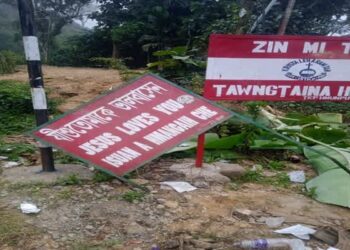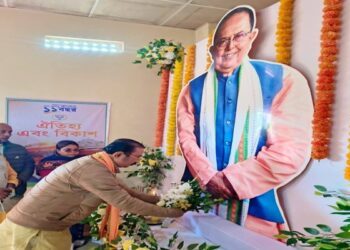Agartala, July 11: Traditional Ker Puja was held in Tripura today. This puja of Janjati was held at Ujjayanta Palace in Agartala according to tradition. On the occasion of Ker Puja, the Prime Minister in a tweet greeted all the people of Tripura and wished everyone happiness, harmony and good health. Besides, Chief Minister of Tripura congratulated everyone on the occasion of Ker Puja.
Ker Puja is one of the religious festivals of Tripura dynasty. On Shukla Panchami in the month of Shravan, the seven days of Kharchi Puja ends in the temple of the 14 deities, and the Ker Puja begins seven days later. All the rituals that are seen in the worship of the gods and goddesses of Hinduism, are not seen in the worship of Ker. First of all, there are no idols of gods and goddesses in this puja. Its rituals are truly unparalleled. This pooja is performed to ward off the fear of primordial forces and the ritual priest and under whose direction this puja is performed is called Chantai. Strict rules are followed in Ker Puja. Just as Chantai obeys that rule perfectly, public announcements are also made to observe this rule. This is also their traditional practice. It is said that whoever breaks this rule will be punished by the divine powers.
Both Ker and Kharchi are worshiped by the royal family and the people of Tripura. But, since the accession of Tripura to India and the establishment of democratic rule, both the pujas have been patronized by the Tripura government itself. In both pujas, the government police are engaged to protect the sanctity of the puja.
There are also several restrictive reforms surrounding Ker Puja. Chantai became the head of the society during these puja days. Chantai Maharaj can punish anyone who violates the reform of Ker Puja for any reason. Nowadays restrictions and restrictions on the worship of Ker remain in force over a large area including the place of worship. However, this Gondi of Ker Puja rules and regulations is now confined to a part of the western side of the Ujjayant Palace. People are not allowed to enter the designated area. The ban was issued at this time. The ban also remains in force from 10 pm to 5 am in a certain zone of the city outside the Rajbari. People living in those places are prohibited from leaving their homes during that period. The ban remains in place for the first 32 hours of Ker Puja.
There are other restrictions, such as no sick person being allowed to stay in the area of Ker Puja. Similarly, if there was an Antaswatva woman in that region at that time, she was sent out of that boundary to preserve the sanctity of the Ker Puja. It is said that the ban was given to prevent the possibility of child birth and death, which could spoil the sanctity of the puja. Members of the royal family and relatives of the Maharaja do not wear shoes. During this time they have to be barefoot. Even the use of umbrellas is prohibited. During this period, any form of entertainment, dance, music, singing is prohibited to appease the primordial forces. Chantai’s Sahkarira can only recite the hymns together.
The Chantai believe that disobeying these restrictions of Ker Puja invokes evil forces and defiles the sanctity of the Puja. After the date of Kher puja was fixed, Chantai arrived at the place of worship in a jeep the previous day. Then the royal officials and the employees of the Tripura Government Devasthanam Committee were there to give him a formal welcome. Who arranges food and accommodation for Chantai and his assistants. The puja begins with the bursting of cannon balls. This is done to announce the commencement of Puja to the citizens. And all rituals of worship begin. Even after the puja is over, the shells are fired.
The next morning, Chantai dressed in royal clothes came to the place of worship. He wears a turban on his head, colorful hanging clothes, a white loose waist band and a golden thread. The symbolic meaning of these garments is that the god is embodied in them. Chantai then, accompanied by his aides and followed by government and royal officials in procession, paid his respects to the ancient ivory and silver throne of the Manikya regime.
They went to Mangalchandi Devi kept inside the palace and offered prayers. After that they were taken to Sadar Deori of Ujjayant Palace and from there proceeded to the designated holy place. The holy place is a rectangular piece of land, which is kept clean and ready for the worship of Ker. Each corner of that rectangular piece of land is planted with green bamboo. These bamboo trees are seen as symbols of gods and goddesses and ancestors The bamboo sticks are shaped like rocks and each one is wrapped with flowers. A canopy in a geometric shape is attached to them. This decoration resembles a temple from the outside. Chantai and attendants chanted hymns in unknown languages loudly, which is believed to ward off evil influences. At the Chantai puja place, a fire is lit by rubbing bamboo, after the puja the ashes of the fire are taken home by the tribal and non-tribal people. They believe that the ashes benefit the family and protect them from the evil eye of evil spirits. Sacrifice of animals and birds is also one of the rituals of this puja.
Just as Ker Puja is held in Tripura’s Rajbari Ujjayant Palace and Puran Habeli, similarly common people perform this Puja socially in villages after planting crops.


